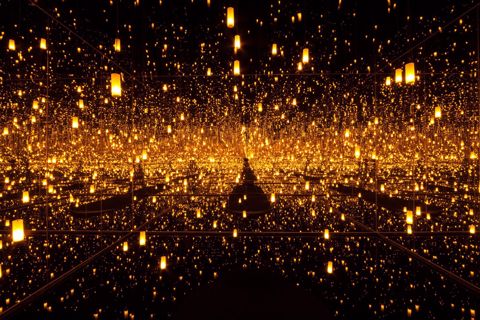The Museum of Fine Arts, Houston, Continues Summer Art Immersions with “Kusama: At the End of the Universe,” June 12 to September 18, 2016

Yayoi Kusama, Aftermath of Obliteration of Eternity, 2009, wood, metal, glass mirrors, plastic, acrylic paint, and LED, the Museum of Fine Arts, Houston, Museum purchase funded by the Caroline Wiess Law Accessions Endowment Fund. © Yayoi Kusama
Yayoi Kusama, Love Is Calling, 2013, wood, metal, glass mirrors, tile, acrylic panel, rubber, blowers, lighting element, speakers, and sound, courtesy of David Zwirner, New York; Ota Fine Arts, Tokyo/Singapore; Victoria Miro, London; KUSAMA Enterprise. Image © Yayoi Kusama
Two of artist Yayoi Kusama’s signature environments will be installed in the Museum’s Mies van der Rohe-designed Cullinan Hall
HOUSTON—May 19, 2016—This summer, the Museum of Fine Arts, Houston, will present two dazzling, immersive environments by contemporary artist Yayoi Kusama. On view from June 12 to September 18, 2016, the exhibition Kusama: At the End of the Universe brings to Houston two of the artist’s signature infinity rooms—Aftermath of Obliteration of Eternity (2009) and Love Is Calling (2013)—the first time this vital aspect of Kusama’s work will be seen in Texas.
Kusama, recently named one of TIME magazine’s “100 Most Influential People,” has worked in an expansive array of media since the 1950s, including painting, drawing, sculpture, film, performance art, and design. Her infinity rooms—environments lined with mirrors that confound viewers' perception of spatial limits—are among her most beloved works, and are the focus of the present exhibition. Kusama: At the End of the Universe also reflects the two complementary aspects of Kusama's career. Aftermath of Obliteration of Eternity, newly acquired by the MFAH, reflects the artist's fascination with the intangible, while Love Is Calling demonstrates Kusama's engagement with our physical environment. The exhibition is further supplemented by one of Kusama’s monumental yellow and black polka-dotted fiberglass pumpkins, which will welcome visitors at the entrance to the gallery.
“We’re especially thrilled to welcome Aftermath of Obliteration of Eternity to its permanent home so swiftly following its acquisition this spring,” said director Gary Tinterow. “This exhibition will offer visitors to the Museum this summer a chance to experience its magic for the first time, in contemplative counterpoint to the exuberance of Kusama’s Love Is Calling.”
“This exhibition celebrates the brilliance of Yayoi Kusama, who has pioneered one of the most remarkable artistic careers of the past century,” commented Alison de Lima Greene, Isabel Brown Wilson Curator of Modern and Contemporary Art. “Dazzling and transcendent, Kusama: At the End of the Universe ushers us into the artist's extraordinary cosmos.”
Aftermath of Obliteration of Infinity (2009) is an intimate space illuminated by an array of golden lights that ignite and then fade into darkness. Viewers enter and stand in the center of the room, finding themselves enveloped by a seemingly infinite horizon and then confronted by an equally infinite void. Love Is Calling (2013) greets viewers who pass through the room with glowing, tentacle-like forms that shoot up from the floor and hang down from the ceiling. Covered in the artist’s signature polka dots, these soft sculptures constantly change color. Further amplifying the experience is a sound recording of Kusama’s voice as she recites a love poem in Japanese, which echoes through the installation.
Admission Information
Each of the room-size installations allows for a limited number of individuals at one time. The Museum will provide timed entry tickets for this exhibition. Visitors can arrange for a timeslot on arrival at the Museum. A limited number of “fast pass” tickets for expedited access to the exhibition will be available. Please visit mfah.org/kusama for more information.
About the Artist
Born in 1929 in Matsumoto, Japan, and coming of age during the devastation of World War II, Yayoi Kusama began her formal training in traditional Japanese-style painting (nihonga) at the Kyoto Municipal School of Arts and Crafts in 1948. Feeling constrained by the conservatism of mainstream art in Japan, she departed for New York City in 1957, where she became amongst the foremost innovators of her generation. Often associated by critics with both Pop and Minimalist currents in the 1960s, she broke down boundaries between traditional studio practices, performance, and installation art through her radical command of space and her direct engagement with her audiences. Kusama returned to Japan in 1973. While choosing to live in seclusion, Kusama maintains her studio in Tokyo, where she continues to write and make art.
Organization and Funding
This exhibition is organized by the Museum of Fine Arts, Houston, with Alison de Lima Greene, Isabel Brown Wilson Curator of Modern and Contemporary Art.
About the Museum of Fine Arts, Houston
Established in 1900, the Museum of Fine Arts, Houston, is among the 10 largest art museums in the United States, with an encyclopedic collection of more than 65,000 works dating from antiquity to the present. The main campus comprises the Audrey Jones Beck Building, designed by Rafael Moneo and opened in 2000; the Caroline Wiess Law Building, originally designed by William Ward Watkin, with extensions by Ludwig Mies van der Rohe completed in 1958 and 1974; and the Lillie and Hugh Roy Cullen Sculpture Garden, designed by Isamu Noguchi and opened in 1986. Additional spaces include a repertory cinema, two libraries, public archives, and facilities for conservation and storage. Nearby, two house museums—Bayou Bend Collection and Gardens, and Rienzi—present American and European decorative arts. The MFAH is also home to the Glassell School of Art and its acclaimed Core Residency Program and Junior and Studio Schools; and the International Center for the Arts of the Americas (ICAA), a leading research institute for 20th-century Latin American and Latino art.
1001 Bissonnet, Houston, Texas 77005 | www.mfah.org | 713.639.7300
Media Contact
Laine Lieberman, publicist
713.639.7516 / llieberman@mfah.org
